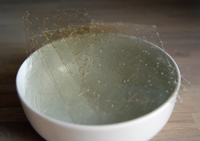
Photo from wikipedia
Magnetic remanence - found in bar magnets or magnetic storage devices - is probably the oldest and most ubiquitous phenomenon underpinning technological applications of magnetism. It is a macroscopic non-equilibrium… Click to show full abstract
Magnetic remanence - found in bar magnets or magnetic storage devices - is probably the oldest and most ubiquitous phenomenon underpinning technological applications of magnetism. It is a macroscopic non-equilibrium phenomenon: a remanent magnetisation appears when a magnetic field is applied to an initially unmagnetised ferromagnet, and then taken away. Here, we present an inverted magnetic hysteresis loop in the pyrochlore compound Nd$_2$Hf$_2$O$_7$: the remanent magnetisation points in a direction opposite to the applied field. This phenomenon is exquisitely tunable as a function of the protocol in field and temperature, and it is reproducible as in a quasi-equilibrium setting. We account for this phenomenon in considerable detail in terms of the properties of non-equilibrium population of domain walls which exhibit a magnetic moment between domains of an ordered antiferromagnetic state which itself has zero net magnetisation. Properties and (non-equilibrium) dynamics of topological defects play an important role in modern spintronics, and our study adds an instance where a uniform field couples selectively to domain walls rather than the bulk.
Journal Title: Physical Review B
Year Published: 2018
Link to full text (if available)
Share on Social Media: Sign Up to like & get
recommendations!